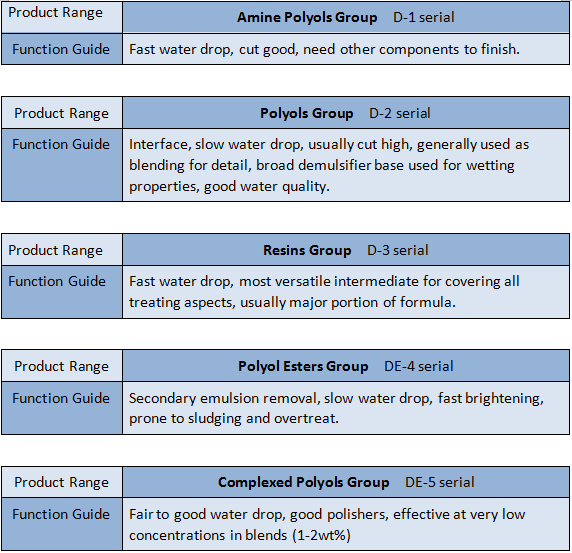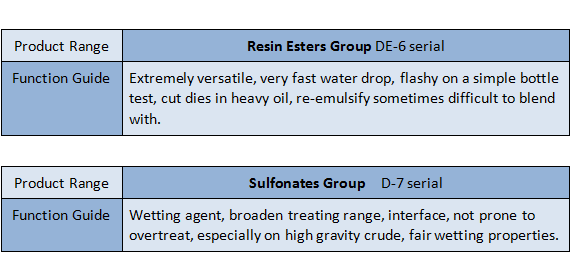PRODUCTION CHEMICALS
DEMULSIFIER
Phase Separation
Demulsifier Intermediates
Crude oil is almost always produced as a water-in-oil emulsion, that is, water droplets stabilized in a continuous crude oil phase. The water and dissolved salts in the emulsion must be separated out before the oil is acceptable for further transportation or treatment at a refinery. This process is called “demulsification” or “dehydration.”
Emulsions are formed owing to turbulence in the production tubing and pipeline, and especially when passing through chokes such as at the wellhead.
The most important method of resolving the emulsion is to add a demulsifier. The concentration of the added demulsifier is usually in the range of 5–500 ppm based on the water phase. Sufficient mixing/dispersing is required to get the demulsifier to the oil–water interface, and time must be allowed for the coalesced droplets to phase separate.
DESHI has a wide range of demulsifier intermediates (neat chemicals or concentrates) which are designed to treat the wide variety of emulsion and desalting problems experienced in oil production.
Functions


BOTTLE TEST
Materials and Methods
To evaluate the best demulsifiers for each type of crude oil, it is usually conducted “bottle tests” where the real dehydration process is simulated in laboratory conditions. Although crude oil treatment is a continuous process, with large residence time, bottle tests are conducted in a static way. Depending on the “bottle tester” the test to be conducted is pretty much the same, but sometimes there are some variations in terms of agitation rate, sampling point for interface evaluation and others.
The experimental procedure for a conventional “bottle test” is described below. At this test, analysis of water and sediments (BS&W) is considered for the treated oil by centrifugation method according to ASTM D 96.
Equipments and Reagents
• Glass syringes (50 and 25 ml)
• Heating bath
• Analytical scale
• Centrifuge
• 100 ml graduated glass tubes • Graduated centrifuge tubes
• Transfer pipettes - 50, 500, 1000 μL
• Glass bottles, 15 ml
• Thermometer (-10 to 120 °C)
• Kerosene
• Technical grade Xylene
• Technical grade Ethanol
Crude Oil Preparation
The crude oil sample from the field must be representative of the current dehydration process. The actions below are very important for good testing reproducibility.
- Sample collection without demulsifiers contamination used in field.
- Removal of free water before starting the test itself.
- Blending of oil samples produced in several fields representing the real oil composition of the dehydration plant
Laboratorial Procedure
First the demulsifier samples must be diluted at 2% concentration in active content. To achieve the desired proportion, solids analysis can be conducted using a microwave automated scale to measure solvent concentration before and after dilution. Dilution is made using ethanol.
“Bottle test” itself consists taking crude oil sample and placing it in 100 ml graduated bottles. The demulsifier agent is added using a micropipette with respective volume in microliters to give the final dosification required in the bottle, usually in ppm levels. The bottles are shaken and let it rest in a heated bath considering the process temperature of oil treater. Measurements of water drop are taken in a pre determined space of time.
To determine the Total Water and BS for the crude oil, approximately 10 ml of treated oil sample is taken and transferred into a centrifuge bottle graduated in percentage, with half of its volume filed with oil. The volume is completed with kerosene and homogenized. Centrifugation is done for 5 min at 3000 rpm and then readings of water separation at the bottle are done. This number should be multiplied by two and results are recorded in a worksheet as W1. Three drops of the “Slug” demulsifier are added to the bottle and mixed well again. Centrifugation is done one more time for 3 min at speed of 5000 rpm. The amount of water obtained at the bottom multiplied by two is recorded as W2. BS is basically the difference between W2 and W1.
In a design of experiments (DOE), tests are conducted in a planned sequence, where the factors (or controlled variables) are amended so as to assess their impact on the response variable. This can allow further statistic analysis with results obtained as well as to use previous data obtained for better modeling of the phenomenon adding more data in another DOE.
The first design of experiment elected to be conducted was the Simplex Centroid Design.
This design mainly consists:
• All combinations of two factors at equal levels
• All combinations of three factors at equal levels
• A center point run with equal amounts of all the ingredients is included.
The main response variables for the bottle test experiments can be considered as below:
Water drop (ml/min): Represents the amount of water found at the bottom of the bottle after some time in the heating bath.
Water Quality: The water quality is classified according to visual assessment: 1-5 (1 - poor 5 - good) Cloudy / Clear.
Interface Quality: The quality of the interface is classified according to visual assessment: 1-5 (1 - poor 5 - good) Rough / diffuse / Sharp
Thief Grind-out: It corresponds to the evaluation of the interface water / oil. After removing the water from the bottom of the bottle, a sample is withdrawn at the bottom for BS&W analysis.
Composite Grind-out: It corresponds to evaluation of oil obtained after the test. After removing the sample for "Thief" analysis, the bottles are shaken again and another sample is taken for BS&W analysis.
W1: This refers to the volume of water found in the centrifuge tubes after centrifuging. A treatment that can reduce W1 to minimum levels with no residual emulsion indicates that good dryness was achieved.
W2: This refers to the volume of water found in the centrifuge tubes after second centrifuging. W2 indicates the total amount of water (free water plus emulsion) after treatment.
EM: This is the amount of emulsion observed visually after the centrifuging operation.
Figure 4. Representation of the value found for "W1" and "EM"
BS: It is the difference between the values of W1 and W2 respectively found at the first centrifuging and second centrifugation with the addition of demulsifier "Slug." Basically this is the value that represents how much water in emulsion phase remained after the treatment with the studied demulsifier.
For the study here proposed just the variables Water Drop Speed, Interface Quality, BS and W1 are considered for statistical modeling.
Shandong Deshi Petroleum Engineering Group Limited.